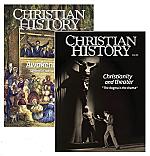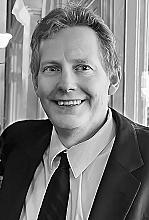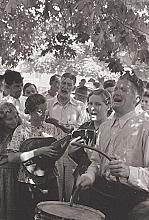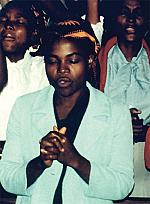Global outpouring: Did you know?
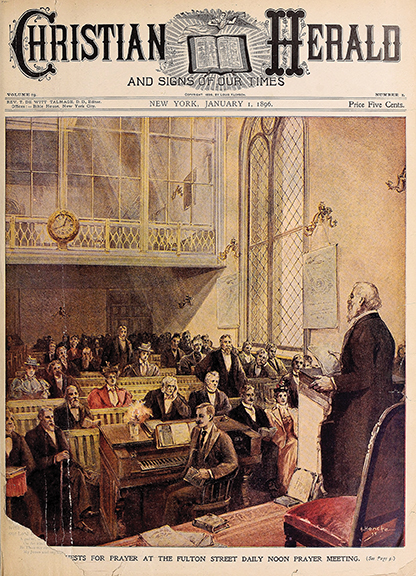
[Above: A. Hencke, Requests for Prayer at the Fulton Street Daily Noon Prayer Meeting in The Christian Herald, Vol. 19, 1896—Public domain, Wikimedia]
Business as Unusual
In 1857 a struggling New York City church envisioned an outreach to people who worked in nearby companies. They hired a businessman, Jeremiah Lanphier (1809–1898), to make that happen. He put out a handbill that read: “Prayer meeting from 12 to 1 o’clock. Stop 5, 10 or 20 minutes, or the whole time, as your time admits.”
This midday, midweek meeting took a few weeks to catch on, but when a financial crisis hit, attendance soared—not only in that church, but across the city.
According to one report, as ships entered New York Harbor, they were enveloped by God’s presence. On one vessel the captain and 30 crew members found faith in Christ before even reaching the port. Deep within the battleship North Carolina, anchored in the harbor, four sailors knelt in prayer. As they sang, some shipmates rushed down to mock them, but overcome by the power of God, these mockers fell to their knees in repentance.
Revival spread across the country in the following years. Some historians have estimated that, during this Businessmen’s Revival, about 1 million Americans, out of a total population of 30 million, professed their faith in Christ (see p. 17).
Electrified
Known for his emotional preaching, revivalist Charles G. Finney (1792–1875) described his own experience this way: “The Holy Ghost descended on me in a manner that seemed to go through me, body and soul. I could feel the impression, like a wave of electricity, going through and through me. Indeed, it seemed to come in waves and waves of liquid love; for I could not express it in any other way. It seemed like the very breath of God. I can recollect distinctly that it seemed to fan me, like immense wings.”
Finney’s innovative revival strategies had a profound influence on a young William Booth (1829–1912), who would go on to found the Salvation Army. Another revivalist, Dwight L. Moody (1837–1899), encouraged the world to “Look at the praying Finney, whose prayers, faith, sermons and writings have shaken this whole country.”
Football Fever
When the Welsh revival began in 1904 (see p. 23), its principal preacher, Evan Roberts (1878–1951), was 26 years old. Roberts had been praying for the revival every day for 13 years.
By all accounts, the effects of this movement saturated every level of Welsh society. As Roberts reported,
Wales up to this time was in the grip of football [soccer] fever when tens of thousands of working-class men thought and talked only of one thing. They gambled also on the result of the games. Now the famous football players themselves got converted and joined the open-air street meetings to testify what glorious things the Lord had done for them. Many of the teams were disbanded as the players got converted and the stadiums were empty.
Tongues in Topeka
Many look back to the Azusa Street meetings of 1906 as the beginning of the modern Pentecostal movement (see pp. 18–21), but some of the seeds of Azusa were sown in Topeka, Kansas, five years earlier. At Bethel Bible School, founder Charles Parham (1873–1929) had begun teaching about the baptism of the Holy Spirit and the gift of tongues, challenging students to do their own study.
At a watchnight service leading into New Year’s Day, 1901, one woman in Parham’s class—Agnes Ozman (1870–1937)—spoke in tongues. Other students and Parham himself did so in the following days.
Confession to Make
As the twentieth century dawned, conflict surrounded the Korean church. Japan and Russia fought for control of this nation, and the United States didn’t always have Korean interests at heart. As some Koreans saw it, American missionaries sought to control the church, squelching the rise of indigenous leaders. In 1906 Korean Christians began hearing about the Welsh Revival and expressed a strong desire to receive the same blessing—but they had a lot of frustration and resentment to sort through.
Then in January 1907, the Presbyterian seminary in Pyongyang hosted a two-week Bible conference attended by approximately 1,500 Korean men. Inspired by the sermons of Kil Sun-joo (1869–1935) and his personal confession of sins, hundreds of attendees followed suit with public acts of repentance (see p. 44). As one writer put it, “With such public confession and visible reconciliation the floodgates opened wide.” For several days at this conference, confession and repentance continued through the night. Another observer noted that even the American missionaries seemed “frightened by the presence of a power which could work such wonders.”
The revival spirit spread from the conference to Union Christian College, galvanizing the Korean church’s next generation of leaders.
Fighting Gandhi
V. S. Azariah (1874–1945) and Mahatma Gandhi (1869–1948) fiercely disagreed with each other, despite their similar goals. Azariah became India’s first Anglican bishop in 1912, serving the diocese of Dornakal. With a heart for evangelism and a mind for revival, he had a profound effect on the region. In the 1920s the church grew rapidly, especially among villagers of the Dalit caste, people at the low end of the Hindu social structure, once known as “untouchables.”
The Dalit Revival drew international attention from mission leaders and church-growth scholars. It also got the attention of Gandhi, who strove to improve the situation of the Dalits, but saw Christian conversion as an expression of Western colonialism. In 1938 the two leaders—Azariah and Gandhi—carried on a very public war of words, both fighting for the downtrodden people they loved.
Revival-thon
Revival broke out at Wheaton College in Illinois on February 8, 1950. At a chapel service, one student after another stood up to confess sins and ask for prayer. The meetings continued through the day, for several days, as classes were canceled.
The Chicago papers got wind of it, and then both Time and Life magazines reported on it. “College Revival becomes Confession Marathon” was the Life headline.
Through the years other schools have experienced similar phenomena. In 1962 a revival occurred at Yale University in Connecticut. In 1970, almost exactly 20 years since the Wheaton revival, Asbury College in Kentucky had its own. Some Asbury students took the experience to other colleges.
In 2023 another revival broke out at Asbury, lasting 16 days. It brought at least 50,000 visitors to the little town of Wilmore, Kentucky, and spread to campuses across the country. At one point the hashtag “asburyrevival” had over 24 million views on TikTok. CH
By Chris Rogers and the editors
[Christian History originally published this article in Christian History Issue #153 in 2024]
Chris Rogers is the producer of Asbury Revival: Desperate for More and is working on a Christian History Institute miniseries on revivals.Next articles
Global outpouring: Letters to the editor
Readers respond to Christian History
readers and the editorsGlobal outpouring: Executive editor’s note
In some cases God not only revived people, but also revived the earth.
Bill CurtisSeven characteristics of revivals
What do movements of the spirit have in common?
Michael J. McClymondFiat or partnership?
Theologies of revival may be closer in practice than they are in theory.
Michael J. McClymondSupport us
Christian History Institute (CHI) is a non-profit Pennsylvania corporation founded in 1982. Your donations support the continuation of this ministry
Donate



